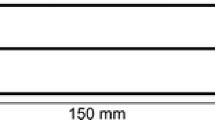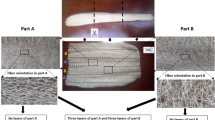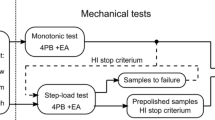Abstract
The present work focuses on investigating the effect of laminate thickness on quasi static indentation behavior of glass/epoxy laminates under acoustic emission monitoring. The load bearing and energy absorbing capability of the glass/epoxy samples at different indentation depth were examined. The damage development and damage mechanisms associated with the tests were characterized in both thin and thick samples, and their results were correlated. The results showed that the thickness of the glass/epoxy laminates significantly influenced the damage onset load, residual deformation and damage area. It was observed that the thick samples exhibited higher peak force, greater absorbed energy, and residual flexural load by an average of 2.08, 2.53, and 2.13 times respectively compared to thin samples. In contrast, the permanent deformation and damage area was observed to be 32% deeper and larger in thick samples while the thin samples showed reduced damage area and residual deformation which attributes to greater elastic response caused by large global deformation.













Similar content being viewed by others
References
Cantwell, W.J., Morton, J.: The impact resistance of composite materials—a review. Composites 22(5), 347–362 (1991)
Abrate, S.: Impact on laminated composite materials. Appl. Mech. Rev. 44(4), 155–190 (1991)
Shyr, T.W., Pan, Y.H.: Impact resistance and damage characteristics of composite laminates. Compos. Struct. 62(2), 193–203 (2003)
Reis, L., Freitas, M.: Damage growth analysis of low velocity impacted composite panels. Compos. Struct. 38(1–4), 509–515 (1997)
Naik, N.K., Borade, S.V., Arya, H., Sailendra, M., Prabhu, S.V.: Experimental studies on impact behaviour of woven fabric composites: effect of impact parameters. J. Reinf. Plast. Compos. 21(15), 1347–1362 (2002)
Amaro, A.M., Reis, P.N.B., Moura, M.F.S.F.: Residual strength after low velocity impact in carbon-epoxy laminates. Mater. Sci. Forum 514–516, 624–628 (2006)
Zhang, Z.Y., Richardson, M.O.W.: Low velocity impact induced damage evaluation and its effect on the residual flexural properties of pultruded GRP composites. Compos. Struct. 81, 195–201 (2007)
Chenghong, H., Yubin, L., Zuoguang, Z., Zhijie, S.: Impact damage modes and residual flexural properties of composite beam. J. Reinf. Plast. Compos. 27(11), 1163–1175 (2008)
Santiuste, C., Sanchez-Saez, S., Barbero, E.: Residual flexural strength after low-velocity impact in glass/polyester composite beams. Compos. Struct. 92, 25–30 (2010)
Atas, C., Icten, B.M., Küçük, M.: Thickness effect on repeated impact response of woven fabric composite plates. Composites B 49, 80–85 (2013)
de Morais, W.A., Monteiro, S.N., d’Almeida, J.R.M.: Effect of the laminate thickness on the composite strength to repeated low energy impacts. Compos. Struct. 70, 223–228 (2005)
Boundi, H., Marple, Jr L.R., Marshall, A.P.: Normal and oblique impact damage on thick- section composite laminates. In: Recent advantages in the structural dynamic modeling of composite roter blades and thick composites. American Society of Mechanical Engineers, Aerospace Division (Publication), vol. 30. New York, ASME (1992)
Cantwell, W.J.: Influence of target geometry on the high velocity impact response of CFRP. Compos. Struct. 10(3), 247–265 (1988)
Flores Johnson, E.A., Li, Q.M.: Experimental study of the indentation of sandwich panel with carbon fiber reinforced polymer face sheets and polymeric foam core. Compos. B 42, 1212–1219 (2011)
**ao, J.R., Gama, B.A., Gillespie Jr., J.W.: Progressive damage and delamination in plain weave S-2 glass/SC-15 composites under quasi-static punch-shear loading. Compos. Struct. 78, 182–196 (2007)
Bull, D.J., Spearing, S.M., Sinclair, I.: Investigation of the response to low velocity impact and quasi-static indentation loading of particle-toughened carbon-fiber composite materials. Composites A 74, 38–46 (2015)
Sutherland, L.S., Soares, C.G.: The use of quasi-static testing to obtain the low- velocity impact damage resistance of marine GRP laminates. Composites B 43, 1459–1467 (2012)
Caprino, G., Lopresto, V., Langella, A., Leone, C.: Damage and energy absorption in GFRP laminates impacted at low-velocity: indentation model. Procedia Eng. 10, 2298–2311 (2011)
Caprino, G., Langella, A., Lopresto, V.: Elastic behaviour of circular composite plates transversely loaded at the centre. Composites A 33, 1191–1197 (2002)
Adamsa, R.D., Cawley, P.: A review of defect types and non-destructive testing techniques for composites and bonded joints. NDT E Int. 21(4), 201–222 (1988)
Fotouhi, M., Ahmadi, M.: Acoustic emission-based study to characterize the initiation of delamination in composite materials. J. Thermoplast. Compos. Mater. 29(4), 519–537 (2014). https://doi.org/10.1177/0892705713519811
ASTM E 569-97: Standard practice for acoustic emission monitoring of structures during controlled stimulation (1998)
Fotouhi, M., Pashmforoush, F., Ahmadi, M., et al.: Monitoring the initiation and growth of delamination in composite materials using acoustic emission under quasi-static three- point bending test. J. Reinf. Plast. Compos. 30(17), 1481–1493 (2011)
Suresh Kumar, C., Arumugam, V., Santulli, C.: Characterization of indentation damage resistance of hybrid composite laminates using acoustic emission monitoring. Composites B 111, 165–178 (2017)
Ramirez-Jimenez, C.R., Papadakis, N., Reynolds, N., Gan, T.H., Purnell, P., Pharaoh, M.: Identification of failure modes in glass/polypropylene composites by means of the primary frequency content of the acoustic emission event. Compos. Sci. Technol. 64, 1819–1827 (2004)
Arumugam, V., Barath Kumar, S., Santulli, C., Joseph, Stanley A.: Effect of fiber orientation in uni-directional glass epoxy laminate using acoustic emission monitoring. Acta Metall. Sinica (English Letters) 24, 351–364 (2011)
Asokan, R., Arumugam, V., Santulli, C., Barath Kumar, S., Joseph, Stanley A.: Investigation of the strength of the failure modes in GFRP laminates using acoustic emission monitoring. Int. J. Poly. Technol. 3(2), 57–65 (2011)
ASTM D 6264-98(04): Test method for measuring the damage resistance of a fiber- reinforced polymer-matrix composite to a concentrated quasi-static indentation force
Kim, J.-K., Mackay, D.B., Mai, Y.-W.: Drop-weight impact damage tolerance of CFRP with rubber-modified epoxy matrix. Composites 24(6), 485–494 (1993)
Mouritz, A.P.: The effect of underwater explosion shock loading on the flexural properties of GRP laminates. Int. J. Impact Eng 18, 129–139 (1996)
Andrew, J.J., Arumugam, V., Saravanakumar, K., Dhakal, H.N., Santulli, C.: Compression after impact strength of repaired GFRP composite laminates under repeated impact loading. Compos. Struct. 133, 911–920 (2015). https://doi.org/10.1016/j.compstruct.2015.08.022
Asokan, R., Dinesh, M., Arumugam, V., Dhanaraj, R.: Experimental investigation of GFRP lap joint failure mechanisms using acoustic emission. Int. J. Veh. Struct. Syst. 4(2), 48–52 (2012)
Kotsikos, G., Evans, J.T., Gibson, A.G., Hale, J.: Use of acoustic emission to characterize corrosion fatigue damage accumulation in glass fibre reinforced polyester laminates. Polym. Compos. 20(5), 689–696 (1999)
Kim, S.T., Lee, Y.T.: Characteristics of damage and fracture process of carbon fibre reinforced plastic under loading-unloading test by using AE method. Mater. Sci. Eng. A 234, 322–326 (1997)
Barre, S., Benzeggagh, M.: On the use of acoustic emission to investigate damage mechanisms in glass-fibre-reinforced polypropylene. Compos. Sci. Technol. 52, 369–376 (1994)
Author information
Authors and Affiliations
Corresponding author
Rights and permissions
About this article
Cite this article
Saravanakumar, K., Lakshminarayanan, B.S. & Arumugam, V. Effect of Thickness and Denting Behavior of Glass/Epoxy Laminates Subjected to Quasi-Static Indentation (QSI) Loading Under Acoustic Emission Monitoring. J Nondestruct Eval 37, 63 (2018). https://doi.org/10.1007/s10921-018-0519-8
Received:
Accepted:
Published:
DOI: https://doi.org/10.1007/s10921-018-0519-8




